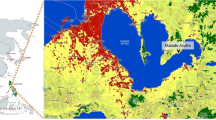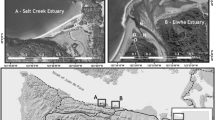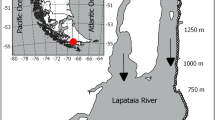Abstract
This paper documents changes in three villages of the Ponoy River region, Murmansk, Russia between 2006 and 2020. Two keystone species—the Atlantic salmon (Salmo salar) and northern pike (Esox lucius) as well as an introduced species, the pink salmon (Oncorhynchus gorbuscha), were studied to determine changes to fish and fisheries. Oral histories, community-based observations and literature data are used to establish key messages on river health from the 1800s to 2020, including temperature data from 1864 to present. Climate change becomes increasingly evident and impacts the Ponoy River system from 1980s onwards with system-relevant changes becoming more pronounced in late 2010s. This coincides with proliferation of pink salmon from 2006 onwards. The species was introduced from the Russian Far East in the 1930s. Very few long-term community-based observation processes have taken place in the Russian North and this paper corrects this to certain extent. Ponoy River and region are important as the last major roadless wilderness area of the European North. Societal and climate changes are rapidly impacting the river and its catchment area as well as the available biological resources and consequently the local culture. This study shows the value of local communities to determine base lines and highlight ongoing changes when establishing climate change impacts and impacts of an alien species.









Similar content being viewed by others
Data availability
Snowchange is safe-guarding the materials of Indigenous knowledge and other data items in the central archives. Additionally, a regional coordinator placed in the community of Lovozero has copies of the field materials. This safeguards them from loss and at the same time protects data items from unlawful use. Materials can be available for scientific purposes after consultation with Snowchange to safeguard that future use is according to prior-informed consent. 2001–2008 Sámi materials are also placed in the regional Sámi museum in Siida, Inari, Finland.
References
Alekseev MY, Tkachenko AV, Zubchenko AV et al (2019) Distribution, spawning and the possibility of fishery of the introduced pink salmon (Oncorhynchus gorbusha Walbaum) in rivers of Murmansk Oblast. Russ J Biol Invasions 10:109–117
Allemann L (2018) “I do not know if Mum knew what was going on”: social reproduction in boarding schools in Soviet Lapland. Acta Borealia 35:115–142
Ambrose WG Jr, Clough LM, Johnson JC et al (2014) Interpreting environmental change in Coastal Alaska using traditional and scientific knowledge. Front Mar Sci 1:40. https://doi.org/10.3389/fmars.2014.00040
Astakhov V, Shkatova V, Zastrozhnov A, Chuyko M (2016) Glaciomorphological map of the Russian Federation. Quat Int 420:4–14
Carrie J, Wang F, Sanei H, MacDonald RW, Outridge PM, Stern GA (2010) Increasing contaminant burdens in an Arctic fish, burbot (Lota lota) in a warming climate. Environ Sci Technol 44:316–322
Carter J (2015) Glasnost on the Ponoi. Fly Fisherman 46:3
Colbourne R, Anderson R (2020) Indigenous wellbeing and enterprise. Self-determination and sustainable economic development, Routledge, London
Filatov NN, Litvinenko AV, Bogdanov MS (2016) Water resources of the Northern economic region of Russia: state and use. Water Resour 43:779–790
Fryer P, Lehtinen A (2013) Iz’vatas and the Diaspora space of humans and non-humans in the Russian North. Acta Borealia 30:21–38
Gordeeva N, Salmenkova EA, Prusov SV (2015) Variability of biological and population genetic indices in pink salmon, transplanted into the White Sea. J Ichtyol 55:69–76
Hayden B, Myllykangas JP, Rolls RJ, Kahilainen KK (2017) Climate and productivity shape fish and invertebrate community structure in subarctic lakes. Freshw Biol 62:990–1003
Helskog K (2012) Bears and meanings among hunter-fisher-gatherers in Northern Fennoscandia 9000–2500 BC. Camb Archeol J 22:209–236
Huntington HP, Begossi A, Fox Gearheard S et al (2017) How small communities respond to environmental change: patterns from tropical to polar ecosystems. Ecol Soc 22(3):9
ICES (2019) Report of the working group on North Atlantic Salmon (WGNAS). ICES Sci Rep 1:16
Kalinin AA, Kazanov OV, Kudryashov NM et al (2017) New promising gold-ore objects in the Strelna Greenstone Belt, Kola Peninsula. Geol Ore Depos 59:453–481
Kalinin AA, Kazanov OV, Bezrukov VI, Prokofiev VY (2019) Gold prospects in the Western segment of the Russian Arctic: Regional metallogeny and distribution of mineralization. Minerals 9:137. https://doi.org/10.3390/min9030137
Kashulin NA, Dauvalter VA, Denisov DB et al (2017) Selected aspects of the current state of freshwater resources in the Murmansk region, Russia. J Environ Sci Health, Part A 52:921–929
Konstantinov Y (2009) Roadlessness and the Person: Modes of Travel in the Reindeer Herding Part of the Kola Peninsula. Acta Borealia 26:27–49
Kritzberg ES, Hasselquist EM, Skerlep M et al (2020) Browning of freshwaters: Consequences to ecosystem services, underlying drivers and potential mitigation measures. Ambio 49:375–390. https://doi.org/10.1007/s13280-019-01227-5
Lunkka J, Kaparulina E, Putkinen N, Saarnisto M (2018) Late Pleistocene palaeoenvironments and the last deglaciation on the Kola Peninsula. Arktos 4:18. https://doi.org/10.1007/s41063-018-0053-z
Magritskii D (2008) Anthropogenic impact on the runoff of Russian rivers emptying into the Arctic Ocean. Water Resour 35:1–14
Makarova O, Khokhlov A (2009) The status and management of moose in the Murmansk Region, Russia. Alces 45:13–16
Makhrov A, Bespalaya J, Bolotov I et al (2014) Historical geography of pearl harvesting and current status of populations of freshwater pearl mussel in the Western part of Northern European Russia. Hydrobiologia 735:149–159
Mankova P (2018) The Komi of Kola Peninsula within ethnographic descriptions and state policies. Natl Papers 46:34–51
Moller H, Kitson JC, Downs T (2009) Knowing by doing: learning by sustainable muttonbird harvesting. N Z J Zool 36:243–258
Moller H, O’Blyver P, Bragg C et al (2009) Guidelines for cross-cultural participatory action research partnerships: A case study of a customary seabird harvest in New Zealand. N Z J Zool 36:211–241. https://doi.org/10.1080/03014220909510152
Mustonen T (2014) Endemic time-spaces of Finland: Aquatic regimes. Fennia - Int J Geogr 192:120–139
Niemelä E, Johansen N, Zubchenko AV et al (2016) Pink salmon in the Barents region with special attention to the status in the transboundary rivers Tana and Neiden, rivers in Northwest Russia and in East Canada. Office of the Finnmark County Governor, Report, p 3
Nikanorov AM, Minia LI, Bruzgalo VA et al (2016) Many-year variations of water pollution and the state of river ecosystems in different latitudinal zones in European Russia. Water Resour 43:791–802
Osherenko G (2001) Indigenous rights in Russia: Is title to the land essential for cultural survival? Geo Int Environ Law Rev 13:695–734
Ozerov M et al (2013) Cost-effective genome-wide estimation of allele frequencies from pooled DNA in Atlantic Salmon. BMC Genomics 14:12
Ozerov MY, Veselov AE, Lumme J, Primmer CR (2012) “Riverscape” genetics: River characteristics influence the genetic structure and diversity of anadromous and freshwater Atlantic Salmon populations in Northwest Russia. Can J Fish Aquat Sci 69:1947–1958. https://doi.org/10.1139/f2012-114
Ozerov M, Vasemägi A, Wennevik V et al (2016) Comprehensive microsatellite baseline for genetic stock identification of Atlantic salmon in Northernmost Europe. ICES J Mar Sci 74(8):2159–2169. https://doi.org/10.1186/1471-2164-14-12
Pauly D (1995) Anecdotes and the shifting baseline syndrome of fisheries. TREE 10:430
Polyakova YI, Novichkova YA, Lisitzin AP et al (2016) Diatoms and aquatic palynomorphs in surface sediments of the White Sea bays as indicators of sedimentation in marginal filters of rivers. Oceanology 56:289–300
Pretty J (2011) Interdisciplinary progress in approaches to address social-ecological and ecocultural systems. Environ Conserv 38:127–139
Simpson L (2017) As we have always done: Indigenous freedom through radical resistance. University of Minnesota Press, Minneapolis
Slezkine Y (1994) Arctic Mirrors – Russia and the small peoples of the North. Cornell Univ Press, Ithaka & London. https://doi.org/10.7591/j.ctvrf89hb
Stephenson J, Moller H (2009) Cross-cultural environmental research and management. J R Soc N Z 39:139–149
Thorstad EB, Næsje TF, Fiske P, Finstad B (2003) Effects of hook and release on Atlantic salmon in the River Alta, Northern Norway. Fish Res 60:293–307
Thorstad EB, Okland F, Aarestrup K, Heggberget TG (2013) Factors affecting the within-river spawning migration of Atlantic Salmon with emphasis on human activities. Rev Fish Biol Fish 18:345–371
Tonteri A, Veselov AJ, Zubchenko AV et al (2009) Microsatellites reveal clear genetic boundaries among Atlantic salmon populations from the Barents and White Seas, Northwest Russia. Can J Fish Aquat Sci 66:717735
Vasiliev A et al (1973) The System of Serebryansk hydroelectric plants on the Voro’ya River. Gidrotekhniches Stroitel’stvo 10:1–5
Velichkin VI, Vorobyova TA, Evseev AV, Miroshnikov AY (2013) Radioecological environment and radiogeochemical regionalisation of Northwestern Russia. Dokl Earth Sci 453:1154–1157
Whoriskey FG, Prusov S, Crabbe S (2000) Evaluation of the effects of catch-and-release angling on the Atlantic salmon of the Ponoi River, Kola Peninsula, Russian Federation. Ecol Freshw Fish 9:118–125. https://doi.org/10.1034/j.1600-0633.2000.90114.x
Zozulya DR, Mitrofanov FP, Peltonen P et al (2009) Lithosphere mantle structure and diamond prospects in the Kola Region: Chemical and thermobarometric analyses of Kimberlite Pyrope. Dokl Earth Sci 427:746–750
Alekseev M, Prusov S (1998) Estimates of conservation limits for Atlantic salmon females for four Russian rivers. ICES CM1998/DD1
AMAP (1998) Assessment Report: Arctic Pollution Issues. Arctic Monitoring and Assessment Programme (AMAP), Oslo, Norway
AMAP (2017) Adaptation actions for a changing Arctic: Perspectives from the Barents Area. Arctic Monitoring and Assessment Programme (AMAP), Oslo, Norway
Azbelov A et al (1963b) Continued study of the seaward migration of the Pacific salmons and the perspectives of their acclimatization in the waters of the White Sea and the Barents Sea. ICES, 1963
Azbelov AA, Bakshtansky EL, Grinjuk IN et al (1963a) Study of the seaward migration of the Pacific Salmons and the perspectives of their acclimatization in the waters of the White Sea and the Barents Sea. ICES CM1963/L65
Brattland C, Mustonen T (2018) How traditional knowledge comes to matter in Atlantic salmon governance in Norway and Finland. Arctic 71:365–482. https://doi.org/10.14430/arctic4751
Britskaya T (2019) Reindeer under fire in Sámi lands. The Barents Observer. https://thebarentsobserver.com/en/ecology/2019/02/reindeer-fire-sami-lands Accessed 24 Sep 2020.
Arctic Council (2013) Arctic Biodiversity Assessment 2013. Status and Trends in Arctic Biodiversity. Conservation of Arctic Flora and Fauna (CAFF) & Arctic Council, Denmark
Danilov A, Reizvikh A (2019) A letter to the United Nations Permanent Forum on Indigenous Issues. 2019
Hilding-Rydevik T, Moen J, Green C (2018) Baselines and the shifting baseline syndrome – exploring frames of references in nature conservation. In: Crumley CL, Lennartsson T, Westin A (eds) Issues and concepts in historical ecology. The past and future of landscapes and regions, Cambridge University Press, Cambridge, pp 112–141
Holmberg A (2018) Bivdit Luosa – To ask for salmon. Saami traditional knowledge on salmon and the river Deatnu: In research and decision-making. Master’s dissertation, The Arctic University of Norway, Tromsø
ICES (2009) Report of the Working Group on North Atlantic Salmon (WGNAS). ICES CM 2009/ACOM:06
ICES (2018) Report of the Working Group on North Atlantic Salmon (WGNAS). ICES CM 2018/ACOM:21
IPCC (2014) Climate Change 2014: Impacts, adaptation, and vulnerability. Part A: Global and sectoral aspects. Contribution of Working Group II to the Fifth Assessment Report of the Intergovernmental Panel on Climate Change. Field, CB, Barros, VR, Dokken, DJ et al (eds). Cambridge University Press, Cambridge, United Kingdom and New York, NY, USA
IPCC (2019) Special report on the oceans and cryosphere. https://www.ipcc.ch/srocc/. Accessed 25 Sep 2020
Johnson N, Alessa L, Behe C et al (2015) The contributions of community-based monitoring and traditional knowledge to Arctic observing networks: reflections on the state of the field. Arctic 68:28–40. https://doi.org/https://doi.org/10.14430/arctic4447
Kirillov J (2020) Report about the BEZRK Land Rent in Lovozero Area. Snowchange Regional Report, available on request
Lehtonen H, Varjo M (2017) Suomen ja Pohjolan kalat. Helsinki: Readme (Fish of Finland and the North)
Miller T (2019) Koitajoki, at https://vimeo.com/337393305. Accessed 9 Oct 2020.
Moller H, O’Blyver P, Bragg C et al (2010) Fourteen years on: Lessons for community-led science partnerships from the Kia Mau te Titi Mo Ake Tonu Atu project. In: Taonui R, Kahi H, Deeming C, Kururangi K, Cooper, Gm Ratahi L, Royal M Taonui R, Haenga M, Bray J (eds) Nga Kete a Rehua Inaugural Maori Research Symposium Te Waipounamu 2008, School of Maori and Indigenous Studies, University of Canterbury, Aotahi
Mustonen T (2018) Golos Ponoi (Russian language newspaper for the Ponoi river) http://www.snowchange.org/pages/wp-content/uploads/2018/12/The-voice-of-Ponoi-final-version.pdf. Accessed 25 Sep 2020
Mustonen T, Feodoroff P (2013) Ponoi and Näätämö River collaborative management plan. Snowchange Cooperative, Kontiolahti. https://pre-uneplive.unep.org/redesign/media/docs/region/ar/naatamo_sisus_1205_p.pdf. Accessed 25 Sep 2020.
Mustonen T, Feodoroff P (2020) What is a River? In Colborne, R. and Anderson, R. Indigenous wellbeing and enterprise: self-determination and sustainable economic development. Routledge
Mustonen T, Mustonen K (2013) Eastern Sámi Atlas. Snowchange Cooperative, Kontiolahti. http://www.snowchange.org/efforts-in-the-skolt-sami-areas-of-naatamo-watershed-finland/eastern-sami-atlas/. Accessed 25 Sep 2020
Mustonen T, Mustonen K (2016) Life in the cyclic world – A compendium of traditional knowledge from the Eurasian North. Snowchange Cooperative, Finland. www.snowchange.org/pages/wp-content/uploads/2016/05/life-in-the-cyclic-world-final-250516.pdf Accessed 24 Sep 2020.
Mustonen T, Mustonen K (2018) Koitajoen erämaataloudet muuttuvassa ympäristössä. http://www.lumi.fi/sivut/wp-content/uploads/2019/01/UUSI-release-koitajoki-150518.pdf (Koitajoki Wilderness Economies in a Changing Environment, about Coregonus fishery)
Mustonen T, Feodoroff P (2014) Report on the collaborative management workshops in Kola Peninsula, Russia and along the Näätämö River catchment area, Finland – working report from 2013 to 2014. Snowchange Cooperative, Kontiolahti. http://www.snowchange.org/pages/wp-content/uploads/2014/05/Snowchange-Ponoi-and-Neiden-2013-Report.pdf. Accessed 25 Sep 2020
Mustonen T, Feodoroff P, Kirillov J (2018) Traditional knowledge of Northern waters. Snowchange, Kontiolahti, Finland. http://www.snowchange.org/pages/wp-content/uploads/2018/12/TraditionalKnowledge.pdf. Accessed 25 Sep 2020
Pecl GT, Araújo MB, Bell JD et al (2017) Biodiversity redistribution under climate change: Impacts on ecosystems and human well-being. Science 355(6332) eaai9214. https://doi.org/10.1126/science.aai9214
Petersson E, Degerman E, Axén C (2018) Översikt, riskbedömning och förslag på åtgärder för puckellax (Oncorhynchus gorbuscha). Aqua reports 2018:17. Dept aquatic resources, Swedish Univ Agric Sci, Drottningholm – Lysekil – Öregrund
Post, E, Alley, RB, Christensen, TR et al (2019) The polar regions in a 2°C warmer world. Science Advances 5:12 eaaw9883. https://doi.org/https://doi.org/10.1126/sciadv.aaw9883
Prusov, S, Whoriskey, FG, Crabbe, SJ (2001) Mark-recapture estimate of the stock abundance of Atlantic salmon aone auring catch-and-release fishing on the Ponoi River, Kola Peninsula, Russia. ICES CM 2001/O:23
Rybråten S, Gómez-Baggethun E (2016) Lokal og tradisjonell økologisk kunnskap i forskning og forvaltning av laks. En forstudie [Local and traditional ecological knowledge in salmon research and management. A preliminary study]. NINA Rapport 1290, Trondheim. p. 80. http://hdl.handle.net/11250/2418802
Sandlund OT, Hårdensson Berntsen H, Fiske P et al (2019) Pink Salmon in Norway: The reluctant invader. Biol Invasions 21:1033–1054. IPCC. https://doi.org/https://doi.org/10.1007/s10530-018-1904-z
Tkachenko A, Prusov S, Karasev AB, Shkatelov AP (2017) Coвpeмeннoe cocтoяниe зapaжeннocти aтлaнтичecкoгo лococя p. Пoнoй (Mypмaнcкaя oблacть) личинкaми нeмaтoды Anisakis simplex/Current Infestation Status of Atlantic Salmon with Anisakis simplex larvae in the river Ponoi (the Murmansk Region). Becтник MГTУ. 20(2): C 455–462. https://doi.org/https://doi.org/10.21443/1560-9278-2017-20-2-455-462
UNFCCC (2020) Commitments to net zero double in less than a year. UN Climate Press Release/21 Sep, 2020. https://unfccc.int/news/commitments-to-net-zero-double-in-less-than-a-year . Accessed 26 Oct 2020.
VKM, Hindar K, Hole LR, Kausrud K et al (2020) Assessment of the risk to Norwegian biodiversity and aquaculture from pink salmon (Oncorhynchus gorbuscha). Scientific Opinion of the Panel on Alien Organisms and Trade in Endangered Species (CITES). VKM report 2020:01, Norwegian Scientific Committee for Food and Environment (VKM), Oslo, Norway
Yang X, Pavelsky TM, Allen GH (2020) The past and future of global river ice. Nature 377:69–73-. https://doi.org/10.1038/s41586-019-1848-1
Zubchenko AV, Loenko AA, Popov NG et al (1996) Atlantic salmon from Russian Rivers, fisheries and state of the stocks in 1995. ICES CM 1996(M:15)
Zubchenko AV, Popov NG, Svenning MA (1998) Salmon rivers on the Kola Peninsula. Some results of acclimation of pink salmon. ICES CM 1998(N:13)
Acknowledgements
We are grateful to Karen Dunmall and Jules Pretty for their very helpful comments and observations on an earlier version of this paper.
Funding
The project has been funded by the Nordic Environment Finance Corporation (NEFCO).
Author information
Authors and Affiliations
Contributions
TM acted as project leader and overall coordinator. JK was local coordinator, while AP, AK, IK and DB performed the field visits and local interviews. MK and HT were scientific advisors to the project. KM analysed the oral history archives and BD conducted the statistical analysis for the temperature data. The manuscript was developed and revised by TM, MK and HT. All authors approved the manuscript.
Corresponding author
Ethics declarations
Conflict of interest
The authors declare that they have no conflict of interest.
Ethical approval
We have complied to international standards related to research ethics in general and more specifically when it comes to working with local communities and indigenous peoples.
Additional information
Publisher's Note
Springer Nature remains neutral with regard to jurisdictional claims in published maps and institutional affiliations.
Rights and permissions
About this article
Cite this article
Mustonen, T., Mustonen, K., Kirillov, J. et al. Community-based monitoring in the Ponoy River, Kola Peninsula (Russia): reflections on Atlantic salmon, pink salmon, Northern pike and weather/climate change. Polar Biol 44, 173–194 (2021). https://doi.org/10.1007/s00300-020-02790-4
Received:
Revised:
Accepted:
Published:
Issue Date:
DOI: https://doi.org/10.1007/s00300-020-02790-4




